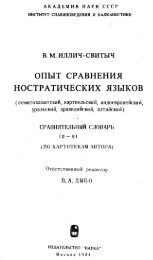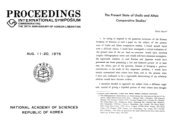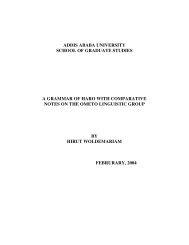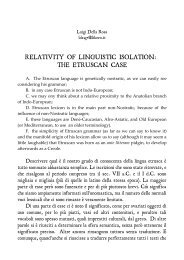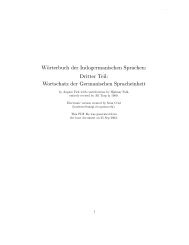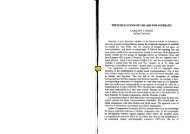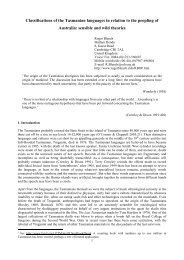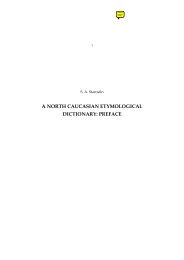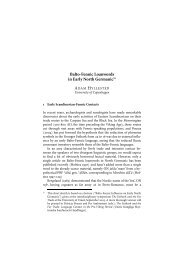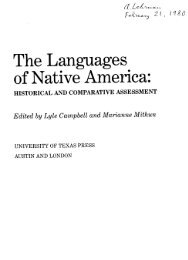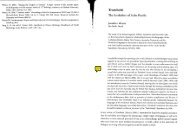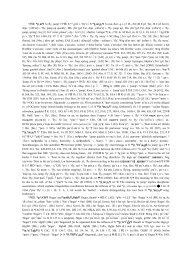The Indo-European Elements in Hurrian
The Indo-European Elements in Hurrian
The Indo-European Elements in Hurrian
Create successful ePaper yourself
Turn your PDF publications into a flip-book with our unique Google optimized e-Paper software.
¯a-pa-a-n- (< *Høep- or<br />
*Høebh-) ‘to set mov<strong>in</strong>g’<br />
(Catsanicos 1996)<br />
¯a-wi-ir-ni (< *Hùowi-)<br />
‘lamb’ (Catsanicos 1996)<br />
8. Comparison of <strong>Hurrian</strong> and <strong>Indo</strong>-<strong>European</strong> Vocabularies 113<br />
(Pokorny 1959:36—37; Walde<br />
1927—1932.I:55—56; Mann<br />
1984—1987:21; Puhvel<br />
1984— .3:84—86 and<br />
3.224—228; Kloekhorst 2008:<br />
285, 319—321, and 327—<br />
328). *Høen-o-s (> *anos)<br />
‘grandmother’ must be<br />
carefully dist<strong>in</strong>guished from<br />
*Húen-o-s (> *anos) ‘mother’<br />
found <strong>in</strong>: Hittite an-na-aš<br />
‘mother’; Lycian ẽni ‘mother’;<br />
Lat<strong>in</strong> anna ‘fosther-mother’;<br />
Greek (Hesychius) Pννίς·<br />
‘mother’.<br />
*Høep- (> *ap-) or *Høebh- (><br />
*abh-) ‘(vb.) to move quickly,<br />
to run, to flow; (n.) (flow<strong>in</strong>g or<br />
runn<strong>in</strong>g) water, river, stream,<br />
current’ (Pokorny 1959:2 and<br />
51—52; Walde 1927—1932.I:<br />
46—47; Mann 1984—1987:1;<br />
Puhvel 1984— .3:114—115;<br />
Kloekhorst 2008:294—295;<br />
Mayrhofer 1956—1980.I:74—<br />
75). Note: <strong>The</strong>re may have<br />
been two variants of this stem<br />
<strong>in</strong> Proto-<strong>Indo</strong>-<strong>European</strong>: (A)<br />
*Høep- and (B) *Høebh-.<br />
*Hùowi- (> *owi-) ‘sheep’<br />
(Pokorny 1959:784; Walde<br />
1927—1932.I:167; Mann<br />
1984—1987:897; Puhvel<br />
1984— .3:279—280;<br />
Kloekhorst 2008:337—338)<br />
‘grandmother’; Lat<strong>in</strong> anus<br />
‘old woman’; Old High<br />
German ana ‘grandmother’;<br />
Old Prussian ane ‘grandmother’.<br />
Hittite ¯a-aš-ša-aš<br />
‘progeny, issue, offspr<strong>in</strong>g,<br />
descendant’ (< *Høons-o-s [cf.<br />
Melchert 1994:163]); ¯a-aššu-<br />
‘k<strong>in</strong>g’ (< *Høons-u-),<br />
which Puhvel (1984— .3:<br />
240—246) <strong>in</strong>terprets as be<strong>in</strong>g<br />
from ‘Born One’ or ‘Begotten<br />
One’.<br />
Hittite (dat. sg.) ¯a-pa-a<br />
‘stream’, (3rd sg. pres. act.)<br />
¯a-pa-a-iz-zi ‘to make wet, to<br />
moisten’ (?); Palaic (nom. sg.)<br />
¯a-a-ap-na-aš ‘river, stream’;<br />
Luwian (nom. sg.) ¯a-a-pí-iš<br />
‘river’, *¯apā(i)- ‘to irrigate,<br />
to water’, (acc. sg.) ¯a-pa-a-ti<strong>in</strong><br />
‘irrigated land’, (acc. pl.)<br />
¯a-a-pí-<strong>in</strong>-ni-<strong>in</strong>-za ‘little<br />
river’; Lycian χba(i)- ‘to<br />
irrigate’; Sanskrit Zpas-<br />
‘water’; Lat<strong>in</strong> amnis (< *abni-s)<br />
‘river, stream’; Old Irish<br />
ab, abann ‘river’; Old<br />
Prussian ape ‘river, stream’;<br />
Tocharian B āp ‘water, river,<br />
stream’<br />
Sanskrit ávi- ‘sheep’; Greek<br />
–úò, ïqò ‘sheep’; Lat<strong>in</strong> ovis<br />
‘sheep’; Armenian hov-iw<br />
‘shepherd’; Old Irish oí<br />
‘sheep’; Gothic awēþi ‘herd of<br />
sheep’; Old English ēow, ēaw,<br />
ēw ‘sheep’, ēowu, ēowe ‘ewe’,<br />
ēowd, ēowde ‘herd of sheep’;<br />
Old High German ouwi, ou<br />
‘ewe’, ewit, owiti ‘herd of<br />
sheep’; Lithuanian avìs



